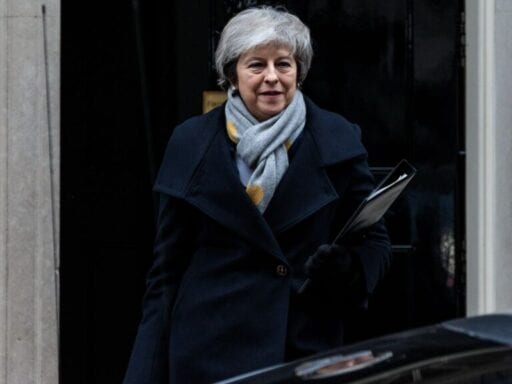May’s government faces a no-confidence vote on Wednesday.
British Prime Minister Theresa May’s Brexit deal was voted down by Parliament on Tuesday, and now she’s set to face another test — a no-confidence vote in her government.
Labour leader Jeremy Corbyn called for the vote almost immediately after members of Parliament struck down May’s deal by 230 votes, one of the most crushing losses for a government in recent history.
May, in addressing MPs after her stunning defeat, made clear that she welcomed such a motion. “We need to confirm whether this government still enjoys the confidence of the house,” the prime minister said. “I believe that it does, but given the scale and importance of tonight’s vote it is right that others have the chance to test that question if they wish to do so.”
The vote, which will take place on Wednesday, could alter the course of Brexit and throw British politics into further turmoil. It could bring about general elections and a new prime minister. Or it could leave the UK where it started, with May as prime minister and a Brexit deadline looming, with no agreed-upon deal, and no obvious solution.
Here’s what’s going to happen on Wednesday
Members of Parliament will debate the issue and then vote on whether they have confidence in May’s government or not. The vote is expected at about 7 pm local time (2 pm Eastern.)
This vote is different than the no-confidence vote May survived in December because that was initiated by members of her own Conservative Party. Because she blocked that coup, she can’t face another vote of no-confidence from Conservatives for 12 months.
. @jeremycorbyn has tabled a no confidence motion in the Government after their historic defeat on Theresa May’s deal. The Government have confirmed that this will be debated and voted upon tomorrow. pic.twitter.com/c1hdmLuKrB
— Labour Whips (@labourwhips) January 15, 2019
This no-confidence vote was initiated by Labour, and backed by other opposition parties, and goes before the entire House of Commons. If May wins this no-confidence vote, she stays in power, and goes back to figuring out what the heck to do about Brexit.
If May’s government is defeated, this kicks off a 14-day time period for Parliament to figure out what to do next, and try to form a new government. May could try to reconstitute her government, or she could resign and let another member of her party try to rally support. Opposition parties will also jockey to form a new government. Whatever the outcome, members of Parliament also have to approve (aka say they have confidence) in this new government going forward.
If, after two weeks, no new government was in place, it would trigger a general election. That can’t happen immediately — at least 25 working days — but it would likely take a few weeks to actually hold general elections.
Is May likely to win or lose?
May’s government is in power thanks to a partnership between her Conservative Party and the Democratic Unionist Party (DUP), a Northern Ireland party. The DUP was vocally and aggressively opposed to May’s Brexit deal, and voted to defeat it.
But the DUP’s members said Tuesday that they would reject a move to take down May’s government, backing the prime minister.
There are also plenty of Conservatives who do not like May, specifically some of the hardline Brexiteers who helped launch the revolt against her last month. But so far, according to reports, these pro-Brexit Tories appear willing to support May.
May’s Conservatives are split between those hardline Brexiters who want a clean break with the EU, loyalists who will back her deal, and some Remainers who either would prefer to avoid Brexit altogether, or lay out a stronger post-Brexit partnership.
But even considering these divides, party loyalty matters. And it might come down to this: Protect May, or risk Labour winning and Jeremy Corbyn becoming prime minister.
Author: Jen Kirby
Read More



